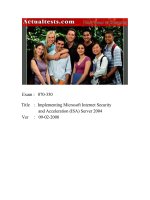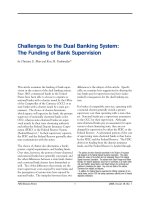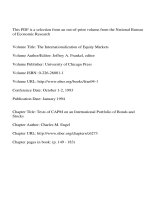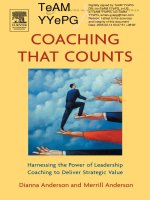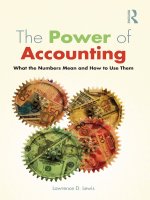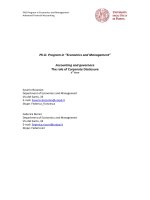Harnessing the Power of Continuous Auditing_1 docx
Bạn đang xem bản rút gọn của tài liệu. Xem và tải ngay bản đầy đủ của tài liệu tại đây (1.02 MB, 31 trang )
FPREF 12/10/2010 14:24:30 Page 14
Harnessing the Power
of Continuous Auditing
FFIRS 12/10/2010 14:5:48 Page 2
FFIRS 12/10/2010 14:5:48 Page 3
Harnessing the Power
of Continuous Auditing
Developing and Implementing
a Practical Methodology
ROBERT L. MAINARDI
John Wiley & Sons, Inc.
FFIRS 12/10/2010 14:5:49 Page 4
Copyright # 2011 by John Wiley & Sons, Inc. All rights reserved.
Published by John Wiley & Sons, Inc., Hoboken, New Jersey.
Published simultaneously in Canada.
No part of this publication may be reproduced, stored in a retrieval system, or trans-
mitted in any form or by any means, electronic, mechanical, photocopying, recording,
scanning, or otherwise, except as permitted under Section 107 or 108 of the 1976
United States Copyright Act, without either the prior written permission of the
Publisher, or authorization through payment of the appropriate per-copy fee to the
Copyright Clearance Center, Inc., 222 Rosewood Drive, Danvers, MA 01923, (978)
750-8400, fax (978) 646-8600, or on the Web at www.copyright.com. Requests to
the Publisher for permission should be addressed to the Permissions Department,
John Wiley & Sons, Inc., 111 River Street, Hoboken, NJ 07030, (201) 748-6011,
fax (201) 748-6008, or online at />Limit of Liability/Disclaimer of Warranty: While the publisher and author have used
their best efforts in preparing this book, they make no representations or warranties with
respect to the accuracy or completeness of the contents of this book and specifically
disclaim any implied warranties of merchantability or fitness for a particular purpose. No
warranty may be created or extended by sales representatives or written sales materials.
The advice and strategies contained herein may not be suitable for your situation.
You should consult with a professional where appropriate. Neither the publisher nor
author shall be liable for any loss of profit or any other commercial damages, including
but not limited to special, incidental, consequential, or other damages.
For general information on our other products and services or for technical support,
please contact our Customer Care Department within the United States at (800) 762-
2974, outside the United States at (317) 572-3993 or fax (317) 572-4002.
Wiley also publishes its books in a variety of electronic formats. Some content that
appears in print may not be available in electronic books. For more information about
Wiley products, visit our web site at www.wiley.com.
Library of Congress Cataloging-in-Publication Data:
Mainardi, Robert L., 1964––
Harnessing the power of continuous auditing : developing and implementing
a practical methodology / Robert L. Mainardi.
p. cm. — (Wiley corporate F&A series)
Includes index.
ISBN 978-0-470-63769-2 (hardback) ISBN 978-1-1180-0700-6 (ebk);
ISBN 978-1-1180-0701-3 (ebk); ISBN 978-1-1180-0702-0 (ebk)
1. Auditing, Internal. I. Title.
HF5668.25.M35 2011
657
0
.458—dc22 2010037965
Printed in the United States of America
10987654321
FFIRS 12/10/2010 14:5:49 Page 5
To my father, Angelo Michael Mainardi, who continues to inspire me as he
watches over me, and to my mother, Lucy, who impresses me more everyday.
FFIRS 12/10/2010 14:5:49 Page 6
Contents
Preface xi
Acknowledgments xv
Chapter 1: Defining Co ntinuous Auditing 1
The Real Definition 1
Differentiating Continuous Auditing 6
Segregating Continuous Auditing and Control Testing 9
Continuous Auditing Objectives 10
Dispelling the Continuous Auditing Myths 11
Summary 13
Chapter 2: Where to Begin 14
Recognize the Need 14
Potential Need/Fit Considerations 15
Client Relationship Score 18
Summary 25
Chapter 3: Continuous Auditing Methodology Development 26
Continuous Auditing Methodology 26
Methodology Requirements 27
Summary 33
Chapter 4: Preparing for a Continuous Audit 34
Building the Business Knowledge 34
Developing Business Knowledge 35
Understanding the Rules 46
Identifying Technology 51
Summary 53
vii
FTOC 10/31/2010 16:35:50 Page 8
Chapter 5: Continuous Auditing:
Foundation Phase 54
Target Area 54
Testing Objectives 63
Frequency 70
Testing Technique 74
Summary 79
Chapter 6: Continuous Auditing:
Approach Phase 80
Approach Phase 80
Scope 81
Volumes 83
Sampling 86
Testing Criteria and Attributes 91
Technology 94
Summary 98
Chapter 7: Continuous Auditing:
Execution Phase 100
Execution Phase 100
Performance 100
Exception Identification 105
Summarizing Results 110
Summary 115
Chapter 8: Root Cause Analysis 116
Root Cause 116
Root Cause Defined 117
Team Understanding 119
Do I Need to Find Root Cause? 124
Root Cause ‘‘Why’’ Approach 125
Root Cause Keys 126
Summary 127
Chapter 9: Continuous Auditing Reporting
and Next Steps 129
Reporting and Next Steps 129
Reporting Options 130
viii
&
Contents
FTOC 10/31/2010 16:35:50 Page 9
Advantages and Disadvantages of Report Type 139
Reporting Options Summary 140
Five-Component Approach 147
Next Steps 153
Summary 155
Chapter 10: Action Plans 157
Action Plans 157
Addressing Root Cause 158
Creating the Perfect Action 159
Components of a Real Action Plan 165
Action Plan Tracking 169
Summary 170
Chapter 11: Continuous Auditing Conditions 171
Conditions 171
Business Unit Management Conditions 173
Internal Audit Conditions 187
Technology Conditions 201
Summary 206
Chapter 12: Selling Continuous Auditing 208
Selling 208
Business Unit Management 209
Audit Team 215
External Clients 220
Summary 222
Chapter 13: Continuous Auditing Challenges 223
Challenges 223
Internal Audit Department 224
Client 230
Summary 233
Chapter 14: Continuous Auditing Uses and Users 235
Uses and Users 235
Uses 236
Users 240
Summary 242
Contents
&
ix
FTOC 10/31/2010 16:35:50 Page 10
Chapter 15: Continuous Auditing Lessons Learned 243
Lessons Learned 243
Developing Technique 244
Effective Concept 246
Lessons Learned Template 248
Summary 248
Appendix: Continuous Auditing Guidance 251
About the Author 269
Index 271
x
&
Contents
Preface
C
ONTINUOUS AUDITING HAS BEEN around for quite some time,
but there has always been an active discussion regarding its true
definition and how to effectively incorporate the targeted testing
methodology into an existing audit department. The other challenge that
internal audit departments face is to differentiate continuous monitoring from
continuous auditing. Although there does not appear to be a significant
difference between the two, the one thing that remains constant is that a
monitoring approach will not provide any control validation.
There is always a risk that audit departments, in an effort to implement a
more streamlined testing approach, will rush through critical development
and implementation phases of the continuous auditing methodology. It is
critically important that each department takes the necessary time to
understand the objectives of the approach, adequately plan and document
its own methodology, and facilitate the communication of the methodology
to its own team and business partners. The development of the continuous
auditing methodology is time consuming and requires adequate planning
and resources. However, this up-front investment will pay off significantly as
the methodology is implemented.
This book addresses many misconceptions about continuous auditing;
none is more significant than the belief that in order to implement continuous
auditing successfully, the internal audit department must be supported by an
automated technology. This could not be further from the truth. Continuous
auditing programs are being executed daily with out any technology at all. The
true key to a successful continuous auditing implementation is not the type of
technology solution used but the detailed, documented continuous auditing
xi
FPREF 12/10/2010 14:24:30 Page 12
methodology that you have developed to support your existing risk-based
audit approach.
This book defines the continuous auditing methodology and provides a
practical, step-by-step guide on how to define, develop, communicate, imple-
ment, manage, and maintain the approach. The objective of the book is to
ensure that any reader—whether auditor, company executive, business unit
manager, practitioner, consultant, or any other busine ss professional interested
in a target approach to evaluating the effectiveness of critical controls—can
clearly understand and successfully create and implement his or her own
continuous auditing methodology.
Chapter 1 provides a clear definition of continuous auditing that is used as
a foundation for the rest of the book.
Chapter 2 helps you identify how continuous auditin g can be integrated
into your existing methodology with a need and fit questionnaire encompass-
ing five specific questions to ensure that a benefit will be realized once the
continuous auditing methodology is developed and implemented.
Chapter 3 discusses the requirements of the critical fields that are required
and should be included in the formal continuous auditing methodology
document and provides a suggested format.
Chapter 4 outlines the specifics of preparing to perform a continuous
auditing program. This is accomplished by detailing the requirements of
developing the business knowledge, understanding the specific business pro-
cess rules, and identifying the technology. Each one of these topics is required to
execute the corresponding work program successfully.
Chapters 5, 6, and 7 provide the individual continuous auditing method-
ology requirements for the three phases: (1) foundation, (2) approach, and
(3) execution. Each chapter defines each phase and its purpose and specifies
the particular deliverables needed to document the continuous auditing
methodology properly.
Chapters 8, 9, and 10 address the continuous auditing methodology
reporting requirements. They encompass the critical need for root cause
analysis (Chapter 8), the suggested report format and documentation require-
ments (Chapter 9), and the definition of real action (Chapter 10) that must be
obtained to address the opportunities for improvement identified during the
execution phase of the conti nuous auditing methodology.
xii
&
Preface
FPREF 12/10/2010 14:24:30 Page 13
Chapter 11 focuses on the business unit management, internal audit, and
technology conditions that provide guidance and assistance during the devel-
opment, implementation, and management of the continuous auditing
methodology.
Chapter 12 discusses the selling of the continuous auditing methodology to
the business unit client and to the internal audit department staff. Although the
method is not the same as a full-scope audit, it is necessary for internal audit to
understand and be able to appropriately articulate the continuous auditing
methodology to all parties involved.
Chapters 13 and 14 provide guidance in recognizing the challenges of
implementing the custom methodology and its specifi c potential uses.
Chapter 15 provides a tool that can be utilized to evaluate and record the
successes and opportunities for improvements in planning, testing, executing,
and reporting on the continuous auditing methodology.
The Appendix provides a detailed example of a successful continuous
auditing methodology as well as all the templates mentioned throughout the
book.
Preface
&
xiii
FPREF 12/10/2010 14:24:30 Page 14
Acknowledgments
T
HROUGHOUT THE BOOK DEVELOPMENT and writing process, I
had tremendous support from many people. I want to say thank you to
everyone who waited patiently and tolerated my unavailability from
the concept phase up to and including the final revisions.
First, I owe special thanks to my son, Robert, and my daughter, Gabrielle,
for all of their sacrifices during the creation of this book. Because of their
understanding, I was able to focus and dedicate all of my time and effort to
writing. You are both amazing, and I could not be any more proud to say that I
am your fathe r.
Thanks to Marilyn for taking care of everything while I worked on
developing this book. You provided the support that made it possible for me
to concentrate solely on writing during each free moment. I appreciate
everything that you did and singlehandedly addressed over this long process.
Thanks to my brothers Jerry, Michael, and Stephen: Jerry for being my
own personal technology help desk; Michael for being my constant supporter
and motivator; and Stephen for always making me laugh when I needed it.
You guys are the best brothers on the planet.
Thanks to Barumbi for the inspiration and support during this creation. I
look forward to working with you long into the future. Your unique insight and
skills should be shared. I look forward to seeing you often.
Thanks to my best friend, Lieutenant Colonel Henry ‘‘Pat’’ Campbell. You
have been by my side since Penn State, and I know that I can always count on
you and Laura for support or anything I could ever need. Always remember
Filet, Tom Z, Kevin ‘‘Ice’’ Anderson, and laughing until it hurts. I want to also
say thank you again for your 21 years of service in the U.S. Air Force. You are a
xv
FLAST 11/23/2010 16:18:37 Page 16
true hero, and I want you to know how much I appreciate all you have done
and that you inspire not only me but also everyone you meet.
Thanks to my two financial gurus, John ‘‘Sma Sma Smitty’’ Smith and
Donna Whiteley. I appreciate everything that you do for me on a daily basis.
Your efforts do not go unnoticed.
Thanks to two of the best people I ever hired, Stephanie Jones and Victoria
Robinson. I appreciate your effort, team dedication, and willingness to follow
me on new adventures at different companies. We created great work environ-
ments, produced valuable audits, and built great relationships. Your creative-
ness and ingenuity regarding the audit process have helped shape the initial
creation of this continuous auditing methodology.
Thanks to Ken Frantzen for helping me get through all of those painful
Monday morning staff meetings. Our five years together were such an adv en-
ture. I appreciate your patience and willingness to always listen. Ken, I finally
made it to the ‘‘big boy’’ table.
Thanks to Dino and Scott Borghi at Borghi’s Restaurant for always taking
care of me, my clients, family, and friends. Your food, dedication to excellence,
superior service, and making everyone (especially me) feel like family are just a
few reasons for your success.
Thanks to my business partners over the years. Although I may have
forgotten some, this list includes: Suzanne Barron, Jill Benson, Lina Borrelli,
Tom Cassidy, Kristi Coombs, Arnaldo Diaz, Ken Ebbage, Cynthia Fetterman,
Todd Freeman, Jorge Green, John Hall, Denise Johnson, Susan Panzer, Jimmy
Parker, Vinit Rajpara, Bruce Rice, Cyndi Summers, and John Wisz.
Thanks to all my former audit team members over the years. I am sure I
have forgotten a few names, but the list includes: William Baugh, Robin Benns,
Bob Campbell, Lisa Chadwick, Andrew Cooper, Jayne Cravens, Jeff ‘‘Hefe’’
Croasmun, Lou DiGiovine, Cari DeRose, Sam ‘‘Pooh Bear’’ Dungee, Mike Eyre,
James Huff, Denise Joyce, Alton Knight, Eric Kramer, Ola Laniya, Tomeka Lee,
Cara McWilliams, Ed Merenda, Jim Mullin, Christopher Nace, Jason Pandolfo,
Eric Pettis, Jack Rockenbach, Frank Satterthwaite, Deborah Sullivan, Crystal
Tucker, Jennifer Valentine, and Dwayne Weldon.
Thanks to Erin and Cathy at Catarinas for always fitting me in and taking
care of me; and to Maria Martin at Unique Images for taking a great picture.
xvi
&
Acknowledgments
FLAST 11/23/2010 16:18:37 Page 17
Harnessing the Power
of Continuous Auditing
FLAST 11/23/2010 16:18:37 Page 18
C01 11/23/2010 16:9:3 Page 1
1
CHAPTER ONE
Defining Continuous
Auditing
THE REAL DEFINITION
One of the significant challenges facing internal audit, control specialists,
enterprise risk management teams, and business managers all over the world
is being able to understand what continuous auditing is and how the
approach can be used effectively. As you read through this book, keep in
mind that continuous auditing has been around for decades. As I travel and
speak around the world on this topic, I have found each individual team,
department, or company has its own definition of what it believes the
approach represents and how to maximize its value. So let us start off this
educational process by establishing a clear-cut definition of continuous
auditing and understanding the characteristics that make it a unique
tool. The definition will be broken down into two distinct parts: (1) the
formal ‘‘book’’ definition for personnel familiar with the audit profession and
(2) the ‘‘nonaudit’’ definition for clients to clearly understand the objective of
the approach.
1
C01 11/23/2010 16:9:3 Page 2
Continuous auditing is one of the many tools used within the internal audit
profession to provide reasonable assurance that the control structure sur-
rounding the operational environment is:
&
Suitably designed
&
Established
&
Operating as intended
Before discussing these three components, it is important to immediately
identify a clarification regarding the definition. The assurance regarding the
support structure of the operational environment is provided only for the
specific controls selected during the development of the continuous audit.
This is a critical distinction that must be understood by both the group using
this approach and the client who is partnering in the effort. The continuous
audit is not concluding on the total control e nvironment for the process
selected but only for the selected controls being reviewed. Time and time
again, I have witnessed clients who receive results of a continuous audit
(which was appropriately focused on a specific control) and then extrapolate
the results of the control testing across the entire operation or control
environment. It is not possible to use the results of a continuous audit to
provide validation of an entire operation. Let’s discuss the three critical
components of the definition.
Suitably Designed
Auditors and control experts use the term ‘‘suitably designed’’ constantly
when discussing control testing, but does everyone using the term truly
understand what it means? When considering whether a process or control
is suitably designed, you must be able to examine the supporting process
documentation or clearly w ritten policies and procedures. In the examina-
tion of the inf orm a tio n, you should be able t o ident ify the process flow,
checkpoints, and required reviews necessary to ensure the process flows
along its desired path. ‘‘Suitably designed’’ also implies there are documented
policies and procedures detailing this process flow. These procedures should
be examined to determine a sufficient level of documentation. In making this
determination, a reasonableness test is applied that basically asks whether
2
&
Defining Continuous Auditing
C01 11/23/2010 16:9:3 Page 3
a reasonable person, without intimate knowledge of the area, would be able
to follow the process and execute the tasks required. As anyone does when
looking for sufficient evidence, examine the procedures and consider if there
is enough detail included to perform the work. One of the difficult aspects of
reviewing policies and procedures is that well over 50 percent of the time
the documentation is out of date. In this situation, the reviewer will be
required to perform additional steps to determine if the process is suitably
designed. Those steps could include facilitating meetings with key process
personnel to gain an understanding or creating detailed process maps or
flowcharts. In the end, the goal is to be able to make a conclusion, based on
examined information, that the process has been suitably designed.
Another component to consider when discussing design is the applica-
tion and use of controls. I n the review of the process documentation, there
should be evidence of specific control activity. In other words, can you ident-
ify control points in the process where information is validated, reviewed,
and/or approved before moving to the next critical step in the process?
Control identification is critical in continuous auditing because, as you will
learn in Chapters 5, 6, and 7, the ‘‘key’’ controls are going to be the ones
selected to test using the continuous methodology. To simpli fy the key
control concept, this type of control holds the process together tightly in an
effort to ensure that the desired outcome is achieved as long as the process
does not deviate from the established design. To further the explanation,
consider that if this type of control fails, one of two things will happen: Either
the process will come to a complete stop or the process’s final result will be
incorrect. Controls govern the flow of information and provide assurances to
protect the outcome.
Additionally, a truly suitably designed process will include parameter
requirements, established reporting, and a timely deliverable. Parameter
requirements establish an upper and lower control limit. Every single control
in every business process has control limits. Control limits provide the mini-
mum (lower) and maximum (upper) range of acceptable performance. These
limits communicate the range in which the business unit team must perform
their assigned responsibilities. Without specific limits, there would be no way
to determine whether the process was operating efficiently and effectively. As
an example, when the accounts payable manager says that all expense
reports submitted will be processed and submitted for payment within one
The Real Definition
&
3
C01 11/23/2010 16:9:3 Page 4
to three days of being received, he is providing the control limits for expense
report processing. That range of one to three days provides the control limits
or standard for receiving, reviewing, and approving an expense report for
payment. Each suitably designed process will have these control limits to
provide accountability and guidance for the team. Without control limits, there
would be no accountability for performance, which would make it almost
impossible to audit with a standard for comparison.
Once the limits have been identified, examine the design of the process to
determine if there are any reports generated to measure the process against
the standard. In a suitably designed process, reports will be created that detail
the effectiveness of the control environment to meet the standard created
in the policies and procedures. These reports will also help in developing a
focus for potential continuous auditing tests. The timely component men-
tioned earlier ties to both the reporting and the delivery of the end product.
Having reporting as part of the process design is a must, but it won’t help
the business quickly identify potential problems or create solutions if it is not
timely. If the process being considered processes items multiple times a day,
every day, receiving performance reports on a monthly basis will not be
very valuable. The same can be said about a daily process that just cannot
meet the daily demand. If a process does not have timely reporting or cannot
deliver a timely product, usually the design is flawed, not the personnel
supporting the effort. You have to consider all of these factors when identi-
fying a target area that would be suitable for a continuous audit.
Established
The next consideration after determining whether something is suitably
designed is determining whether the controlled process is established. This
verification may seem simple but it is mission critical in the preparation
stage of developing a value-added continuous audit process. When trying to
identify if a control structure is established, you need to verify that the
process described in the policies and procedures or documented in the
work flow is the actual process in place today. Too often a business unit
has detailed policies and procedures that are not representative of the day-
to-day operational process. The documentation of the current process is
considered a low priority for the business unit due to their daily
4
&
Defining Continuous Auditing
C01 11/23/2010 16:9:3 Page 5
responsibilities taking precedence over the scripting of their activities. If
the controlled process does not agree with the documented process require-
ments, identifying the control points that should be tested as part of a
continuous audit is very difficult.
When presented with the scenario of the actual business process not
agreeing with the policies and procedures, it will be necessary to understand
and document the current process flow before attempting to develop an
approach for continuous auditing. It is not that you would be unable to
create a continuous audit without knowing the process was established; why
would you want to test or verify a process control that is no longer critical or
even applicable to the actual business process being executed on a daily basis?
For the continuous audit tool to be effective and deliver the expected value, it
must be based on the current control process in place and operating today. So
when you are examining a department’s policies and procedures, ensure that
the documented process agrees with what the staff currently is executing.
Once that step has been completed, it will be easier to identify and select the
critical controls that govern the process to producing its results.
Another point to consider regarding an established process is the
communication of the process requirements. With the speed of business
and the demands of customers increasing at an almost daily rate, it is critical
to understand how business units communicate changes in the process
requirements and/or control limits. Very often, processes change without
a formal communication plan. Without a plan to verify that all parties are
aware of the change, it is not possible to ensure compliance. Communication
within a business unit impacts the processing team’s ability to deliver
repeatable, reliable results. Ensure that you verify how process rule changes
are communicated within a team before selecting it for a continuous audit.
This advance knowledge will reduce the amount of potential rework as well
as the number of false positives.
Operating as Intended
The last component of the definition probably seems to be the easiest one to
verify. Pretty simple question: Is the process operating as intended? What this
question really is asking is, is the process creating a result? It is a yes-or-no
question. It is straightforward and doesn’t really require any interpretation.
The Real Definition
&
5

